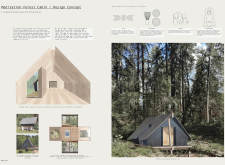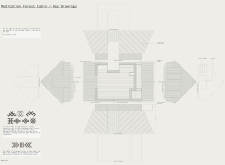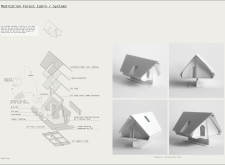5 key facts about this project
Materiality is a key focus of the project. The use of cross-laminated timber (CLT) not only provides structural integrity but also enhances insulation properties, reducing energy consumption. The cabin's cladding features hardwood timber, which adds to its durability and aesthetic appeal. Rigid insulation and a woodchip ecoburner further contribute to the building's energy efficiency. Large areas of glazing facilitate natural light entry while framing views of the surrounding landscape.
Functional components of the cabin include a central communal area that is adaptable for both individual meditation and group gatherings. The internal arrangement promotes flexibility in furniture layout, catering to various activities while allowing for a seamless flow between spaces. Natural ventilation is optimized through strategically placed windows, enhancing occupant comfort.
A unique aspect of the Meditation Forest Cabin lies in its cultural integration. It reflects elements of Latvian folklore and traditional construction methods, which add depth and significance to the architectural design. The high ceilings and open spaces foster a sense of freedom, encouraging occupants to engage with their environment actively.
Additionally, the cabin's roof design recalls the silhouette of traditional gabled structures, contributing to its contextual relevance. This approach also addresses practical concerns, such as effective drainage and weather resistance. The overall design seeks to establish a dialogue between the building and its natural surroundings, reinforcing a sense of place.
In summary, the Meditation Forest Cabin exemplifies a balanced approach to architecture that prioritizes sustainability, cultural relevance, and functional versatility. For a more detailed understanding of the architectural plans, sections, and designs that contribute to this project’s success, readers are encouraged to explore the project's presentation for deeper insights into its architectural ideas and execution.


























